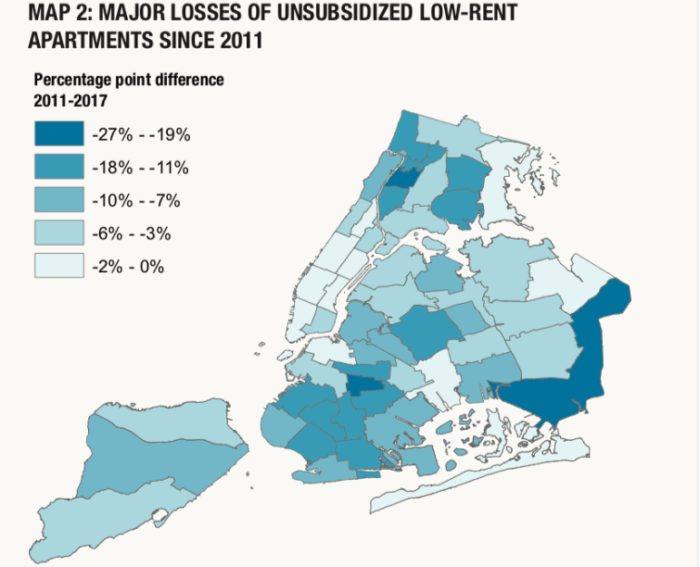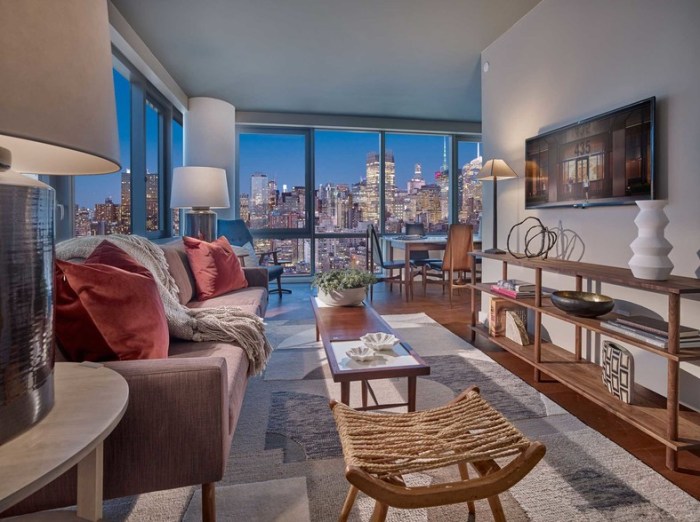House Rent in USA New York A Comprehensive Guide
Average Rent Costs in New York City

Source: citylimits.org
Securing housing in New York City, a global hub known for its high cost of living, requires careful planning and understanding of the rental market. This section details average rent costs across different boroughs, highlighting key factors influencing price variations.
Average Rent Costs by Borough
The following table provides a general overview of average monthly rental costs for different apartment types across New York City’s five boroughs. Note that these figures are estimates and can vary significantly based on location, amenities, and market conditions. Data is based on recent market trends and may not reflect the most current prices.
| Borough | Studio | 1-Bedroom | 2+ Bedrooms |
|---|---|---|---|
| Manhattan | $2,800 | $3,500 | $5,000+ |
| Brooklyn | $2,200 | $2,800 | $3,800+ |
| Queens | $1,800 | $2,300 | $3,200+ |
| Bronx | $1,500 | $1,900 | $2,500+ |
| Staten Island | $1,400 | $1,700 | $2,200+ |
Rent Cost Comparison Across Boroughs
A comparison of average rent costs across the five boroughs reveals significant differences. These variations are primarily driven by factors such as location, demand, and available amenities.
- Manhattan consistently commands the highest rental rates due to its central location, high demand, and limited housing supply.
- Brooklyn offers a range of rental options, with prices generally lower than Manhattan but higher than other boroughs, reflecting its popularity and diverse neighborhoods.
- Queens and the Bronx provide more affordable options compared to Manhattan and Brooklyn, although rents are increasing in certain desirable neighborhoods.
- Staten Island generally has the lowest rental costs in NYC, but this comes with a trade-off in terms of commute times to Manhattan and other major employment centers.
Factors Influencing Neighborhood Rent Prices
Within each borough, neighborhood characteristics significantly impact rental costs. Factors such as proximity to transportation hubs, schools, parks, and the overall safety and desirability of the area contribute to price variations.
For instance, neighborhoods in close proximity to subway lines or major bus routes tend to command higher rents due to the convenience they offer. Similarly, neighborhoods with highly-rated schools and safe, walkable streets often attract higher demand and therefore higher prices.
Factors Affecting Rent Prices
Numerous factors influence the overall cost of renting an apartment in NYC. Understanding these factors is crucial for prospective renters to make informed decisions and manage their budget effectively.
Impact of Apartment Size and Amenities
Apartment size and the presence of specific amenities directly impact rental costs. Larger apartments naturally command higher prices. Similarly, features such as in-unit laundry, parking, and pet-friendliness add to the overall cost.
Correlation Between Public Transportation and Rent
Proximity to public transportation significantly influences rent prices. Apartments located near subway stations or bus routes tend to be more expensive due to their convenience and desirability. Conversely, apartments further from public transport are generally more affordable.
Influence of Neighborhood Safety and School Districts
Neighborhood safety and the quality of nearby schools are key factors affecting rental rates. Areas with lower crime rates and highly-rated schools typically have higher rental costs due to increased demand.
| Factor | Low Impact | Medium Impact | High Impact |
|---|---|---|---|
| Apartment Size | Studio | 1-Bedroom | 2+ Bedrooms |
| Amenities | None | In-unit Laundry | Parking, Pet-Friendly |
| Public Transportation | Long Commute | Moderate Commute | Short Commute/Walkable |
| Neighborhood Safety | Higher Crime Rate | Average Crime Rate | Low Crime Rate |
| School Districts | Lower-Rated Schools | Average-Rated Schools | Highly-Rated Schools |
Finding Apartments in NYC
The apartment search process in NYC can be challenging, but with a systematic approach and utilization of available resources, prospective renters can increase their chances of finding a suitable place.
Step-by-Step Apartment Search Guide
- Determine your budget and needs: Establish a realistic budget, considering rent, security deposit, broker’s fee (if applicable), and utilities. Define your desired apartment features (size, amenities, location).
- Research neighborhoods: Explore different neighborhoods to identify areas that align with your preferences and budget.
- Utilize online resources: Explore various apartment search websites and apps (StreetEasy, Apartments.com, Zillow).
- Schedule viewings: Once you identify potential apartments, schedule viewings to assess the property in person.
- Submit an application: Complete the application process, providing necessary documentation (credit report, proof of income, etc.).
- Negotiate lease terms: Review the lease agreement carefully and negotiate terms as needed.
- Sign the lease and move in: Once you’ve agreed on terms, sign the lease and finalize the move-in process.
Comparison of Apartment Search Websites and Apps
Several websites and apps facilitate apartment hunting in NYC. StreetEasy is a popular choice, known for its comprehensive listings and detailed information. Apartments.com and Zillow offer broader national coverage but still provide a good selection of NYC properties. Each platform has its own strengths and weaknesses; comparing listings across multiple platforms is recommended.
Apartment Application Process
The application process typically involves submitting a completed application form, along with supporting documents such as proof of income, credit report, and references. Expect to pay an application fee. Landlords often conduct background and credit checks.
Lease Agreements and Tenant Rights
Understanding lease agreements and tenant rights in New York State is crucial for protecting your interests as a renter. This section summarizes key aspects of NYC leases and tenant protections.
Common Clauses in NYC Lease Agreements
Typical lease clauses cover rent amount and payment schedule, lease term, tenant responsibilities (maintenance, utilities), and grounds for eviction. Thoroughly review all clauses before signing.
Tenant Rights and Responsibilities
New York State offers robust tenant protections, including regulations regarding rent increases, landlord access to the apartment, and eviction procedures. Tenants have responsibilities, such as maintaining the apartment in good condition and paying rent on time.
Resolving Disputes with Landlords
Disputes with landlords can be resolved through mediation, arbitration, or legal action. The New York State Division of Homes and Community Renewal offers resources for resolving tenant-landlord disputes.
Illustrative Examples of Apartment Listings
The following are fictional examples of NYC apartment listings, illustrating the range of options and information typically provided. These examples are for illustrative purposes only and do not reflect current market conditions.
Fictional Apartment Listing 1
Price: $2,500/month
Location: Williamsburg, Brooklyn
Size: 1-bedroom, 700 sq ft
Amenities: Hardwood floors, in-unit laundry, dishwasher, balcony
Fictional Apartment Listing 2

Source: apartments.com
Price: $1,800/month
Location: Astoria, Queens
Size: Studio, 450 sq ft
Amenities: Renovated kitchen and bathroom, hardwood floors, ample closet space
Fictional Apartment Listing 3
Price: $3,800/month
Location: Upper West Side, Manhattan
Size: 2-bedroom, 1,000 sq ft
Amenities: Pre-war details, high ceilings, in-unit laundry, dishwasher, exposed brick
Typical NYC Apartment Layout: Studio Apartment
A typical NYC studio apartment might measure approximately 400-500 square feet. The space typically combines a living area, sleeping area, and kitchen into one open-plan layout. A small bathroom is usually separated. Dimensions vary greatly depending on the building and the specific unit. Some studios might include a small alcove or separate area for sleeping.
Calculating Total Apartment Costs
Calculating the total cost of renting involves adding the monthly rent, security deposit (usually one or two months’ rent), broker’s fee (if applicable, typically one month’s rent), and estimated monthly utility costs (electricity, gas, water, internet).
General Inquiries
What is a broker’s fee, and is it always necessary?
A broker’s fee is a payment to a real estate agent for assisting in finding an apartment. It’s usually one month’s rent, but not all apartments require a broker. Many landlords list directly, avoiding this fee.
How much should I expect to pay for utilities in NYC?
Utility costs vary depending on apartment size and usage, but expect to budget for electricity, gas, water, and internet. Some buildings include some utilities in the rent; others do not. Always clarify this upfront.
What is a security deposit, and how does it work?
A security deposit is typically one or two months’ rent held by the landlord to cover potential damages to the apartment. It’s usually returned at the end of the lease, less any deductions for repairs.
Securing affordable housing in New York City can be a significant challenge, with rental costs consistently high. If you’re finding the New York market too steep, you might consider exploring alternative locations, such as checking out options for a house for rent in Columbia, which may offer more competitive pricing. house for rent in columbia Ultimately, your decision will depend on your budget and lifestyle preferences, but comparing options across different areas can be beneficial when searching for suitable housing in the USA.
What documents are typically required for an apartment application?
Landlords usually require proof of income (pay stubs, tax returns), credit reports, references, and sometimes a guarantor if your income is insufficient.




















